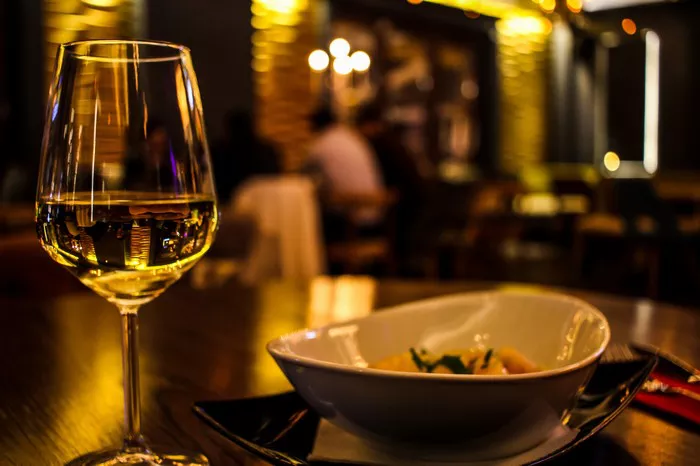Champagne, with its effervescent bubbles and luxurious appeal, demands a certain level of sophistication in its presentation. One often-overlooked aspect is the art of holding a champagne glass. The way you hold your glass not only adds to the overall aesthetic but also enhances your tasting experience.
1. Types of champagne glasses:
1.1 Dish-shaped champagne glass
This flying saucer-shaped cup is the earliest champagne glass, which was especially popular in the 1950s.
The shallow saucer champagne glass is an original classical champagne glass, which is said to be designed based on the shape of a woman’s breast. In 2014, in order to celebrate the 40th birthday of the supermodel Kate Moss, the famous London restaurant 34 Restaurant invited the art master Jane Floyd to use her left chest model to customize a champagne glass, and engraved her signature on the cup holder.
This isn’t the first time a supermodel’s breasts have been recreated in champagne flutes. In 2007, fashion designer Karl Lagerfeld designed an advertisement for the champagne brand Dom Pérignon. Carl’s muse, Claudia Schiffer, was also the brand’s queen model. After Claudia, Carl designed a bowl in the shape of a white breast, with pink nipples pointing down, supported by three bottles of white Dom Pérignon on a silver tray with the designer himself and a superstar. model’s signature. In 2008, it cost $3,150 to buy the combination and a bottle of champagne.
1.2 Flute-shaped champagne glass
After the 1960s, people paid more and more attention to the quality and taste of wine. Although the saucer-shaped champagne glass has a unique shape, it has many shortcomings. Therefore, it was replaced by the flute-shaped champagne glass (Flute), which was actually designed as early as the 19th century, but it has not been called the mainstream until recent decades.
Compared with the saucer-shaped champagne glass, the design of the flute-shaped glass has been greatly modified in the mouth, body and foot of the glass. This style of glass is the best for preserving bubbles and is suitable for dry sparkling wines.
Tips: Pay special attention when using a flute glass. When pouring champagne, you need to tilt the body of the glass and let the glass wall flow down to reduce the loss of bubbles.
1.3 Tulip-shaped champagne glass
Listening to the name, it looks like a tulip to get its name. The tulip glass is between a saucer cup and a flute cup. It not only concentrates the aroma, but also highlights the delicate bubbles of champagne. Suitable for sparkling wines with rich aroma and fruity flavour.
1.4 White Wine
Since 2010, sommeliers and champagne conglomerates have been advocating tasting champagne in white wine glasses. Why? The middle of the white wine glass is wide enough to help the champagne spread and release a good smell. At the same time, the mouth of the cup tightens inward, gathering the aroma and reaching it directly to the nose, making the taste more delicate.
2. The Three-Finger Technique
Hold the Stem: When handling a champagne glass, always hold it by the stem. This prevents the heat from your hand from warming up the contents and ensures that the champagne stays chilled.
Use Three Fingers: Gently grasp the stem using your thumb, index finger, and middle finger. This delicate grip not only keeps the champagne at the ideal temperature but also adds an element of refinement to your posture.
Maintain Elegance: Keep your grip relaxed and graceful. Avoid gripping the glass tightly, as this can hinder the visual appeal and the overall drinking experience.
3. The Pinky Conundrum
One of the most common misconceptions is the notion of extending the pinky finger while holding a champagne glass. Contrary to popular belief, this practice is not a sign of sophistication; rather, it can come across as pretentious.
Skip the Pinky Extension: Keep your pinky finger relaxed and aligned with the rest of your fingers. This creates a more natural and polished appearance.
4. Tilt for Tasting
To truly appreciate the aroma and flavors of champagne, it’s recommended to tilt the glass at a slight angle while holding it. This technique allows the surface area of the wine to expand, releasing its bouquet.
Tilt the Glass: Hold the champagne glass by the stem and tilt it at a 45-degree angle.
Observation: Observe the bubbles rising elegantly towards the surface. Take a moment to appreciate the visual appeal of the sparkling wine.
Inhale Aromas: Bring the glass closer to your nose and take a gentle sniff. Tilt it slightly more to capture the diverse aromas that champagne offers.
5. Sip with Grace
When it’s time to take a sip, continue to hold the glass using the three-finger technique. Allow the liquid to gently touch your palate, and take a moment to savor the intricate flavors.
Small Sips: Champagne is best enjoyed in small sips. This allows you to fully experience the delicate balance of flavors and textures.
Deliberate Movement: As you take a sip, you can gently swirl the glass to enhance the wine’s interaction with air, promoting the release of its complex aromas.
Conclusion:
In the world of champagne, the art of holding a champagne glass is an essential element of the overall experience. By selecting the appropriate glassware, embracing the three-finger technique, and tilting the glass for tasting, you can elevate your enjoyment of champagne to new heights.


